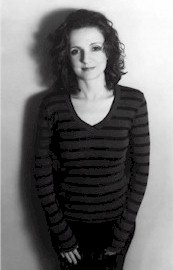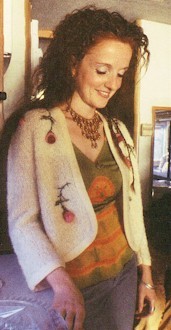Authored exclusively for Pattynet by cherished community member, Marybeth D’Amico.
For many years, Patty Griffin was considered a well-kept insider’s tip. Steadily gaining the recognition she deserves, she is now regarded as one of today’s most significant songwriters. Never making music that’s easy to categorize, her songs move effortlessly from straightforward folk to gospel-tinged ballads right on through to unabashed rock and roll anthems, defying attempts to buttonhole her into a genre. As one critic put it, “It’s music that seems to exist on its own plane, like that of Joni Mitchell or Billie Holiday. One comes to Patty Griffin’s music on her terms, not yours.”
The Early Years

Patty’s musical roots trace back to her upbringing in Old Town, Maine, where she grew up as the youngest of seven children. Her father was a teacher at a nearby high school; her mother, a homemaker of French-Canadian descent. Patty recalls her mother singing around the house, and remembers that she had a beautiful voice, although she never performed publicly. Patty also has said in interviews that much of her early musical inspiration came from rock bands of the 60’s, 70’s and 80’s, such as the Beatles, Bruce Springsteen, Rickie Lee Jones and Tom Petty and the Heartbreakers.
After graduating from high school, Patty moved to Florida for several years, times that are largely undocumented, but recalled in songs such as “Florida” and “Mother of God.” In 1985 she moved from Florida to Boston, marrying musician Nick Cobb in 1988. In Boston, she worked a series of odd jobs from telephone operator to waitress at Cambridge’s Pizzeria Uno. Patty also got to know a number of musicians, and started guitar lessons at the Cambridge Music Center with John Curtis, formerly of the Pousette-Dart Band. Patty says that nearly every week she would come in to her lesson with a new song she had written, until Curtis finally asked her why she wasn’t playing gigs. Too scared to set one up herself, Patty says Curtis eventually began setting up gigs for the two of them around Boston. In a 2004 interview with the Boston Globe, Curtis recalled about Patty that she was “as shy as can be, a total wallflower. But she sang a little song, in this 8-by-8 room, and I had to peel myself off the wall. When she sang, there was no doubt. No doubt at all.”
A woman named Ann Hudner being acting as a manager of sorts for Patty, and put a demo tape sold at gigs into the hands of musician and producer Nile Rogers, who had worked with the likes of Madonna and Duran Duran. Patty was stunned to hear of his interest, and even quit all her day jobs to focus on music after Rogers signed her onto his label, called Ear Candy. However, Patty noted in a recent interview with Warren Zanes of the Rock and Roll Hall of Fame, that in the excitement she signed a “loose and terrible contract” which turned out to sign away many of her rights, including some publishing rights to her future songs. After Ear Candy ran into funding problems, Patty’s deal with Rogers was scaled back into a production deal, and things “went downhill from there,” Patty said. She recorded seven songs with Rogers at the legendary Hit Factory in New York City, but was unhappy with the result. Patty partly blames herself, saying the songs were not up to snuff, but also said that Rogers had no experience in working with a voice like hers. “He took what semblance of songs I had and….I don’t know what you would call that music. It was strange,” she shrugged in the interview. These songs, Patty quipped, are “buried deep in the ground somewhere, guarded by trolls and faeiries.”
After this came a period which Patty described as her own personal Ground Zero. Besides the unraveling of the deal with Rogers, her marriage broke up and she found herself having to take temp jobs to make ends meet. But out of this painful situation, she noted, sprang the songs that would ultimately make up her impressive debut album, Living With Ghosts.
Living With Ghosts

Around 1994, Patty produced a demo of some of these newer songs, which got into the hands of A&M records. A&M decided to sign Patty. This time she went to record in Daniel Lanois’ Kingsway Studios in New Orleans with a full band. Again, however, that effort was ill-fated. The heavily produced album was “beautiful but I felt like I played a really small part in it. Fortunately the record label hated it,” Patty recalled in an interview. She convinced A&M to release her original demos, along with some additional songs in demo format.
The result was her highly acclaimed 1996 debut, Living With Ghosts, today still regarded as an acoustic tour de force. The raw delivery of these 10 evocative songs conveys Patty’s ability to touch on fundamental emotions, from passionate anger in “Every Little Bit,” wry existentialism in “Mad Mission” to the hard-won redemption of “Forgiveness.” Songs such as “Sweet Lorraine” also reveal her skill as a storyteller. The Boston Globe called it “a spare, blazing triumph of folk-rock songcraft and biting poetry,” while the The Philadelphia Inquirer called her songs “little gems full of power and grace and honest-to-goodness melodies.” The Fort Worth Telegraph Star has called Living With Ghosts “one of the most hauntingly gorgeous acoustic discs this side of Springsteen’s Nebraska.” Following the release of Living With Ghosts, Patty set out on a headlining tour. She also joined the Lilith Fair tour for two consecutive years, memorably adding a recording of the powerful song “Cain” to the Lilith Fair compilation.
Flaming Red

While Living With Ghosts established Patty firmly among fans of folk-rock, she was never particularly comfortable with that label. “I always felt like I wrote rock songs. I used to think, don’t call me a folk singer. I felt that kind of stuck me out there with all the daisies,” she has said. To emphasize the fact, Patty’s sophomore effort, Flaming Red, was a raucous rock album that shocked many of her fans. The album, released in 1998, was recorded in Nashville by Jay Joyce, producer of the noisy, adventurous rock band Iodine. Patty demonstrated she could rock with the best on songs such as “Flaming Red,” “Change” and “Wiggley Fingers.” Yet the songs retain the same emotional desperation that she touched on with Living With Ghosts. “Tony” speaks of a lonely teenager who kills himself; “Change” of a woman who lacks self-confidence and is put down by her lover. Critics also began to notice the recurring religious themes in Patty’s music. Two notable occurences — the references to Jesus in “Mary,” a song ostensibly about her grandmother, and the rebellion against a Catholic upbringing in “Wiggley Fingers” — are found on Flaming Red. The record got wide play on college radio stations, and during the subsequent Flaming Red tour, Patty’s notoriety grew as she opened for singers such as Emmylou Harris and Lucinda Williams.
Having since moved to Austin, Texas, Patty became part of the music scene in that city, where the Dixie Chicks became devoted Patty fans. They recorded her song “Let Him Fly” on their 2000 album Fly and invited her to join them on tour promoting the album. “It’s very rare that I come across a CD that I just wear out, and I’ve worn her records out. All three of us have,” Dixie Chick Martie Maguire said in an interview. “If I have a fan come up to me and ask, ‘What do you listen to?,’ I would say ‘Go out and buy Flaming Red.’”
Silver Bell

The ill-fated Silver Bell is known among Patty fans as the greatest album that never was. The fact that an album of this stature remains unreleased seems to sum up for many what’s wrong with today’s music industry. Planned as a follow-up to Flaming Red, the album was slated to be released in September 2000. Working with Jay Joyce and Craig Ross as co-producers, as well as with members of her touring band such as guitarist Doug Lancio and keyboardist John Deaderick, Patty returned to Kingsway Studios in New Orleans to record her third album. Upon its completion, she turned it in to her record company — A&M had since been absorbed by Interscope — and left to tour with the Dixie Chicks. But Interscope sat on the tape, pushing its release back to January 2001, and then to March, while her fans patiently awaited its release. That day never came. According to an article in the Nashville Rage, Patty was told the album lacked “commercially viable singles.” She was released from her contract, but without the masters to Silver Bell. Some of the songs have since been released on other albums, while fans continue to trade the unreleased version of Silver Bell. The album demonstrates an incredible diversity of styles, from the soul-tinged “Perfect White Girls” to hard-rocking “Silver Bell” to the country-influenced “Truth #2.” Patty also again demonstrates her unique storytelling abilities in bittersweet ballads such as “Making Pies” and “Top of the World.”
1000 Kisses

Patty’s fortunes turned, however, when she met Dave Matthews at an Austin City Limits taping in February 2000, in which they both participated. Matthews was so impressed with what he heard that he picked up Patty for his own then-fledgling label, ATO Records. It was under this label that Patty brought out her next album, 1000 Kisses — a sparse, acoustic-oriented album recorded over five days in April 2001 at the Nashville basement studio of Patty’s musician friend Doug Lancio. Patty said in an interview that the idea behind the album was to give the songs a “signature sound” — a unified sound achieved mainly with the unusual combination of cello, accordion and vibes. The dreamy cover art by Austin-based graphic artist Traci Goudie also complemented the mood of the album.
Released in April 2002, 1000 Kisses was again greeted with critical acclaim, and was nominated for a Grammy for Best Contemporary Folk Album. A number of the songs, such as “Long Ride Home,” “Making Pies,” and “Nobody’s Crying” had been in her live repertoire for some time. More recent songs included “Be Careful” and “Rain,” which had been inspired by a fierce rain-storm in Austin. The album’s title track, “Mil Besos,” was a Latin American standard that Patty’s friend Michael Ramos convinced her to record at his home in Texas. Even though she couldn’t speak a word of Spanish, she convincingly delivered the passionate love song.
Patty’s 1000 Kisses tour, with a backup band that included Doug Lancio and Michael Ramos, took up much of 2002, finishing off at the Ryman Auditorium in Nashville on January 30, 2003. The recording of that show, which included appearances by Emmylou Harris and Buddy and Julie Miller, became the ATO Records live CD/DVD release A Kiss in Time, debuting in October 2003. Meanwhile, the Dixie Chicks gave another boost to Patty’s recognition in 2003 by including two of her unpublished Silver Bell songs — “Truth #2” and “Top of the World” — in their blue-grass influenced, best-selling 2003 album Home, released in August of that year. Their continued interest in her work led to wider exposure for Patty, particularly among young fans, and their subsequent tour was even named the Top of the World Tour.
Impossible Dream

During this time, Patty was busy working on her next album, which she told fans “would not include any ear-candy.” What she meant was that her upcoming album was to be very thoughtful and introspective, and would not likely please the fans who wanted her to do another album more in the vein of Flaming Red or the unreleased Silver Bell. Patty’s record company also billed the album as her most personal effort. Impossible Dream was released on April 20, 2004. It was produced by Craig Ross, with vocal contributions from Patty stalwarts Emmylou Harris, and Buddy and Julie Miller. As promised, the album did have a very melancholy and mature feel to it. One personal touch — the inclusion of Patty’s parents singing an excerpt from “The Impossible Dream,” a song from the Broadway musical Man of La Mancha — gives the album its name. Impossible Dream also seems to reflect Patty’s struggle to come to grips with troubled times. “When people are going through more tumultuous times, then your work’s going to reflect that,” said Patty in an interview. “It’s the world. And my age. I’m not a kid anymore. There are some things I need to pay attention to.” A Boston Globe music critic agreed that the album had “an exquisitely measured and purposeful feel” to it. “It’s as if she’s traded youthful aggression for a less dynamic, but far more searching sound — one that suits the time of life and tenor of her art.”
A number of listeners noticed the strong gospel influence in songs such as “Standing” and “Love Throw a Line.” In numerous interviews, Patty mentioned her renewed interest in gospel, particularly the Staple Singers. “They’re sort of talking about very painful things, and yet every time I listen to a Staples record, within 15 minutes I feel really hopeful and uplifted,” Patty said.
Again, Patty had mined her Silver Bell treasure trove for Impossible Dream, including songs such as “Top of the World,” “Mother of God,” and “Standing” (which used the original recording from the Silver Bell sessions). She also included “Florida,” a song that illuminates some of her early years. More recently written was “Kite Song,” which she reportedly wrote as a consolation to her friend Traci Goudie, who was anxious that her brother might have to go to the pending war in Iraq. Some people interpreted “Cold As It Gets” as an anti-war statement. But Patty later explained that she had been inspired to write the song after seeing a documentary on the Holocaust in which concentration camp victims, when liberated, asked for a gun to revenge the people that did this to them. “It was kind of a revelation to me that that kind of darkness would create that kind of darkness, and I thought there would just be relief and, ‘Oh, now we can go home,’ but there was more pain. And that’s what the song came out of,” Patty said in an interview.
Children Running Through

With the release of Children Running Through on February 6, 2007, Patty Griffin seems to have truly come into her own. Not only has her circle of fans widened, giving her her highest debuting album to date, but critics have not been shy about proclaiming this the best album of her career.
“Every other record she has made—and most of them are quite good—seems now to have been a preamble to this work,” declared No Depression, while AllMusic.com called it “a summation of an arrival.” The music critic from the Washington Post hailed it “the work of a gifted singer, songwriter and, for the first time, producer…at the height of her powers.”
Recorded in Austin, TX with producer Mike McCarthy (Spoon) during the summer of 2006, Children Running Through — which draws its title from a poem by the 13th century Persian poet Rumi — draws on all new song material that Patty began working on around 2003. If Children Running Through is less somber in many ways than Impossible Dream — interspersed as it is with rocking numbers such as “Getting Ready,” “Stay on the Ride,” and “No Bad News” — it also demonstrates a new maturity in Patty’s work.
For one, Patty lets through more fully something that listeners of her live performances have enjoyed for years: her powerful voice. In recent interviews, Patty has related how producers in the past had told her her voice was best toned down. That has now clearly been discarded. Both the songs themselves and the production — which puts the vocals out front and center — allow Patty to really let her voice go where she wants it. As in many of her earliest, unreleased songs, her vocal stylings on CRT also show a strong soul influence, in numbers such as “Stay on the Ride,” “Heavenly Day,” and “Up to the Mountain.”
Thematically, there is also a shift in emphasis. If on Impossible Dream Patty was grappling with her reaction to trouble in the world, on Children Running Through she appears to be looking at how to go on in spite of that. “There’s a lot of beauty. There’ s (sic) a lot of powerful things to experience, a lot of special things. You have to bring it down to that,” she told Performing Songwriter.
Even if Patty claims she doesn’t want to be known as the “queen of pain,” there’s nonetheless a mature understanding in these songs of happiness as something fleeting. Even on the buoyant “Heavenly Day,” a song she says was inspired by her dog, the happy talk is measured: “All the trouble went away, for a while anyway, for a while anyway, on this heavenly day.” And the perfectly contented moment captured in “Burgundy Shoes,” in which she rides the bus with her mother as a little girl, has a bittersweet note to it, as a fond memory that won’t come again.
Although Patty has said she focused more on the singing and less on clever lyrics on this album, those who love her character sketches won’t go away disappointed. One could argue that she now has a greater command over how to convey a story with just a few simple, well-chosen phrases. As the reviewer from AllMusic.com put it: “Her songwriting is leaner yet more evocative, her singing stronger and more confident, and her manner of illustration is spot-on; the song is true simply because she delivers it that way.” That applies to one of the CD’s highlights, “Trapeze,” which tells the story of an aging circus performer who lives only for the thrill of flying.
Some people don’t care if they live or they die / Some people want to know what it feels like to fly
The track’s emotional impact is enhanced by a stunning vocal duet with Emmylou Harris.
In “Railroad Wings,” Patty movingly depicts a man looking back on how the love of a good woman saved him from his darker self. And the piano ballad “Someone Else’s Tomorrow,” which stands out on the album as an unusually dark and cryptic song, also belies her statement that lyrics aren’t as important on CRT:
The tall and the tiny ships on the water / Farther and farther, floating away / Will never return now, all wooden and burned out / They echo and groan now in their salty graves / All the memories fade, send the the ghosts on their way / Tell them they’ve had their day, it’s someone else’s tomorrow
The album closes with “Crying Over,” a classic Patty Griffin number both in its simplicity and emotional impact. The songs “Free”, “Up or Down,” and “Moon Song,” all fan favorites, were released only as bonus tracks available from Barnes & Noble and iTunes.
Patty embarked on a national tour in support of Children Running Through in March of 2007. She plans to continue touring throughout the year, including summer festivals and a possible trip to Australia.